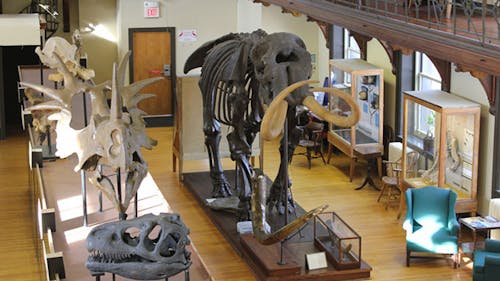FUCHS: Rutgers Geology Museum is hidden gem on campus
Column: Questioning Jules

This past year and a half, my time has largely been spent working on my honors thesis in history. I opted to do a project rather than a paper because I wanted to do something to foster change within the University.
Therefore, I chose to create a detailed catalog and website for the Rutgers University Geology Museum’s (RUGM) Egyptian artifacts. Included in this project is also the small but rich collection of Egyptian artifacts from the Zimmerli Art Museum on the College Avenue campus.
One of the most common questions I have gotten from people while working on this project is “What is the Geology museum?” or “Wait, there is a mummy on campus?” It has come to my attention that the Geology Museum does not get nearly as much attention as it should, which is a shame due to how robust the collection of artifacts is.
Within The Geological Hall on the College Avenue campus lies a gallery of wonders on the second floor. Immediately upon entering, a visitor is greeted with a gigantic mastodon skeleton — a fan favorite in terms of artifacts, for sure. Additionally, there are early hominid skulls, many gemstones, Native American artifacts and a small display of New Jersey dinosaurs (aside from the previously mentioned Egyptian artifacts).
Some of the most popular college-aged visitors are new students. I remember being in the Student Transition Seminar and visiting the museum as a part of an assignment. One of the main reasons I believe college students do not visit the RUGM is due to a lack of knowledge about its existence.
The museum is completely free for Rutgers students and is the perfect place to spend a rainy afternoon or even a break between classes. The entire museum should not take you more than half an hour to get through, as it is not that big.
The Egyptian artifacts in the collection span from a Ptolemaic era mummy whose name was Iset-Ha, to canopic jars and faience bead necklaces. The Egyptian artifacts give visitors a unique and up-close look at antiquities.
There are 80 artifacts in the collection, most of which were used for funerary purposes. The artifacts are housed in the back of the museum, near the resting place of Iset-Ha. The artifacts arrived in the late 1800s and were placed on permanent loan to the RUGM by the New Brunswick Theological Seminary.
The Egyptian artifacts, especially Iset-Ha are unique to Rutgers, yet are not given the foot traffic or prioritization they rightfully deserve. The neglect of museums such as this can not only be attributed to the people not knowing about such institutions but also to an overall lack of care.
In today’s university climate, most people care about STEM fields and putting in time and effort to learn those skills. Some might wonder, “What is the point of learning about the past?” or “How do museums contribute to society?”
The answer is simple: The past teaches us about ourselves and our future. Human nature is constant and issues of the ancient world were not that different from issues of the modern world. There were corrupt leaders, racism, sexism, poverty and unfair class systems even in ancient Egypt. It is important to understand the roots of these issues in order to look toward fostering progressive change.
Additionally, museums are important in preserving the past so that future generations and ourselves can learn about it. The fact of the matter is that all humans leave behind material objects. Without objects that were used in daily life and information on human life through the ages, there is no way to understand the past. Archaeological evidence is most of what we have to tell about the ancient and prehistoric worlds.
Museums are important, especially for college students who are being exposed to new issues and opinions every single day. Rutgers is extremely lucky to have such an amazing institution like the Geology Museum. Students ought to pay it a visit and enjoy all of these broad educational opportunities presented to them.
Julia Fuchs is a School of Arts and Sciences senior majoring in history and anthropology and minoring in French and archaeology. Her column, "Questioning Jules," runs on alternate Thursdays.
*Columns, cartoons and letters do not necessarily reflect the views of the Targum Publishing Company or its staff.
YOUR VOICE | The Daily Targum welcomes submissions from all readers. Due to space limitations in our print newspaper, letters to the editor must not exceed 900 words. Guest columns and commentaries must be between 700 and 900 words. All authors must include their name, phone number, class year and college affiliation or department to be considered for publication. Please submit via email to oped@dailytargum.com by 4 p.m. to be considered for the following day’s publication. Columns, cartoons and letters do not necessarily reflect the views of the Targum Publishing Company or its staff.



